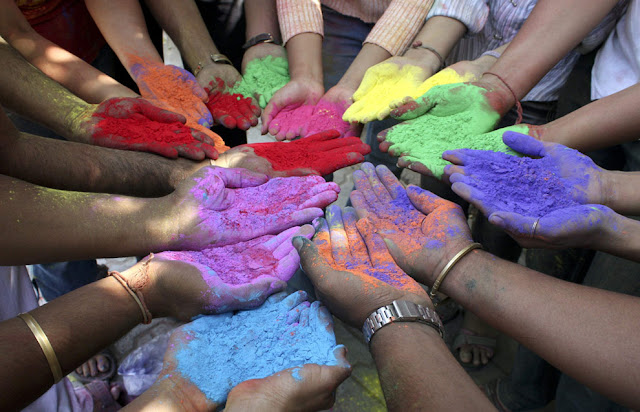Holi is an Indian spring festival on full moon day of the month Phalguna (February / March). This "festival of colors" will take at least two, in some parts of India and up to ten days. Holi is celebrated in North India is mainly a festival that is in other parts of the country known under different names. We are talking about it as Phagwah or, as in Bengal, as Dol Yatra. In the south, known Kamadahana.
Holi, which is one of the oldest festivals will ever be is the most colorful of all. Five days after the full moon is Rangapancami (Ranga = color; Pancami = the 5th lunar day), the second day of the festival. On this day seem all barriers by caste, gender, age and social status revoked. It will celebrate and be sprinkled and sprinkled each other with colored water and colored powder, the gulal. Those who reject the arrogance, smeared each other at least decently with some powder paint. Despite all the changes in modern Indian society, the religious significance is still clearly recognizable, such as the colors are still mostly previously consecrated on the altar and the people to bring about blessings. Originally, the color powder derived from certain flowers, roots and herbs, healing act. Now often synthetic colors are used, some of which may even be harmful.
On the first day they lit in the night a fire and burn it as a figure of straw, called Holika. Various myths deal with this demon: One of the most famous stories:
The infant prince Prahlada should be persuaded by his father to show him all the divine glory, but the boy still worshiped only Vishnu. By various means now the king tried to kill his son, but every time attacked Vishnu himself and saved the child. Finally, the king resorted to a ruse: his sister Holika, who was protected by special forces in front of the fire with Prahlad on her lap should jump into the fire and burned him so. But the flames spared the child and remained only a heap of ashes of Holika. After that, the people celebrate in memory of the destruction of the demon, the festival of Holi.
Closely connected with Holi are the stories of Krishna's childhood and youth. Also, he should with his consort Radha and the other shepherdesses have celebrated the play of colors. Here Hindus interpret the gentle "play" with the color as "purple" Krishna, the symbol of the "Divine Play".
The erotic character of the Spring Festival is also used in hard Kamadahan expressed that people celebrate at the same time in South India: The Legend:
Kama once tried to interfere with the God of love, Shiva in his meditation. But the anger that burned him to ashes with his third eye. Only the pleading of Ratri, Kamas wife soothed him, and he gave him back his life.
Since then this day is dedicated to the god of love.
Like all festivals Holi is also very complex in its meaning. In the spiritual realm, it conveys, as seen in the associated mythology, the message of the triumph of good over evil. In nature, however, it marks the victory of spring over winter, for the festival begins with the blossoming of nature. An important point is the people and the reconciliation aspect, because it means that you should bury these days too old disputes. Frequently, it is customary to consume a Holi Bhang-called drugs. Many drinks also traditionally forbidden alcohol, which develops particularly in the cities by the resulting violence is increasingly becoming a problem.
A very similar to the Holi festival, Nouruz, is celebrated in Iranian culture.































No comments:
Post a Comment